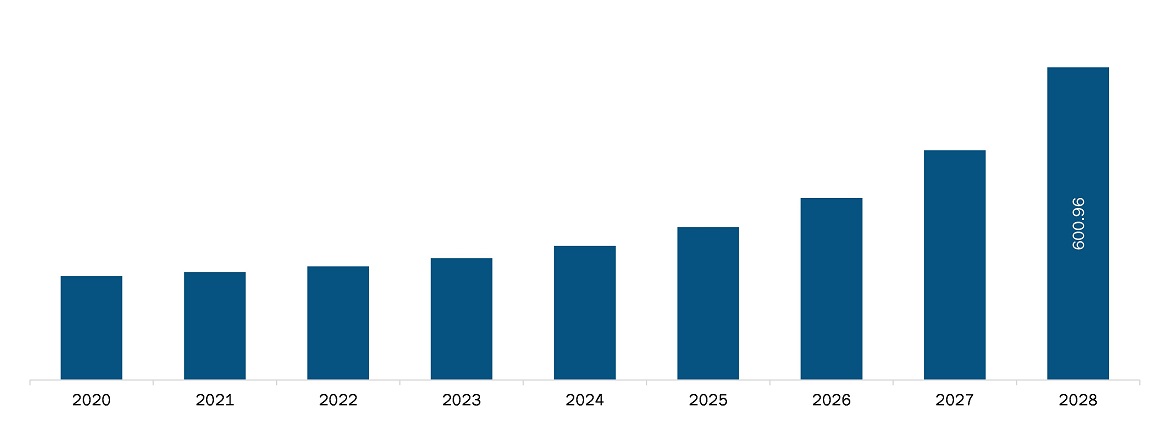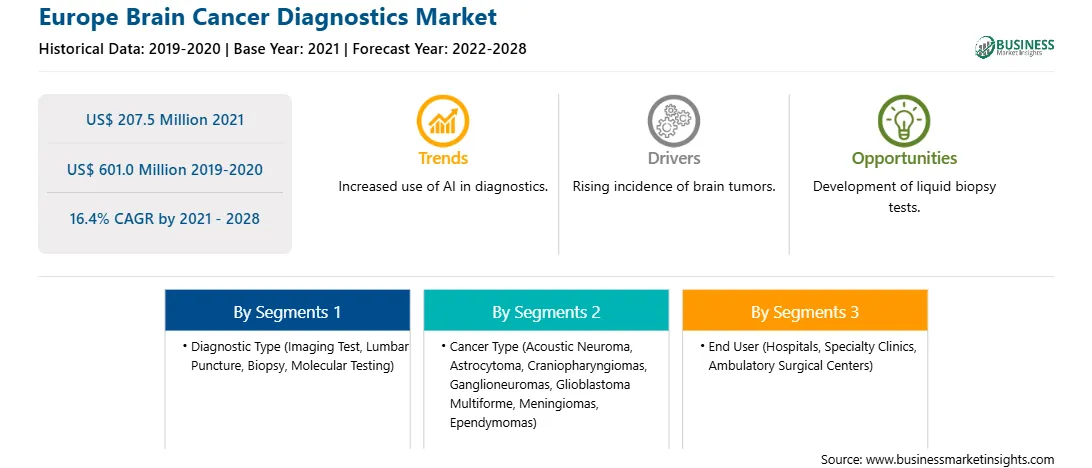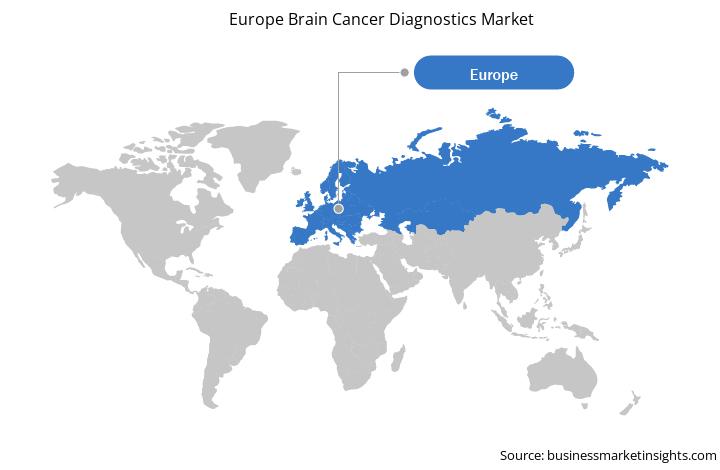Brain cancers are caused due to extracellular growth of the cells in the brain that causes tumors. The tumor includes primary brain tumors and secondary brain tumors. Primary brain tumors are formed in the brain and do not spread to other body parts, whereas secondary tumors, also known as metastases, are those cancers that began in another part of the body. Brain tumors are categorized into 40 major types that are further classified into two major groups, including benign, i.e., slow-growing and have less possibility to spread, and malignant, i.e., cancerous, and more likely to spread.
Thus, the increase in prevalence of brain cancer is expected to create a significant demand for brain cancer diagnostics in the coming years, which is further anticipated to drive the brain cancer diagnostics market.
Patients with cancer have been negatively impacted during the COVID-19 pandemic, as many of these individuals may be immunosuppressed and of older age. Additionally, cancer follow-up or imaging appointments have been delayed in many clinics around the world. Postponement of routine screening examinations will result in delays in new cancer diagnoses. Clinics are continuing to monitor and adapt their appointment schedules based on local outbreaks of COVID-19. Studies on COVID-19 in patients with cancer are limited, but consistently indicate that this population is at risk for more severe COVID-19 illness. Data from recent studies also suggest that pediatric patients with cancer have a lower risk of severe COVID-19 illness compared with adults. Certain features of SARS-CoV-2 infection detected by lung, brain, and gastrointestinal imaging may confound radiologists’ interpretation of cancer diagnosis, staging, and treatment response. Lastly, as clinics begin to reopen for routine appointments, protocols have been put in place to reduce SARS-CoV-2 exposure to patients during their visits. This review details different perspectives on the impact of the COVID-19 pandemic on patients with cancer and on cancer imaging.

Strategic insights for the Europe Brain Cancer Diagnostics provides data-driven analysis of the industry landscape, including current trends, key players, and regional nuances. These insights offer actionable recommendations, enabling readers to differentiate themselves from competitors by identifying untapped segments or developing unique value propositions. Leveraging data analytics, these insights help industry players anticipate the market shifts, whether investors, manufacturers, or other stakeholders. A future-oriented perspective is essential, helping stakeholders anticipate market shifts and position themselves for long-term success in this dynamic region. Ultimately, effective strategic insights empower readers to make informed decisions that drive profitability and achieve their business objectives within the market.

| Report Attribute | Details |
|---|---|
| Market size in 2021 | US$ 207.5 Million |
| Market Size by 2028 | US$ 601.0 Million |
| Global CAGR (2021 - 2028) | 16.4% |
| Historical Data | 2019-2020 |
| Forecast period | 2022-2028 |
| Segments Covered |
By Diagnostic Type
|
| Regions and Countries Covered | Europe
|
| Market leaders and key company profiles |
The geographic scope of the Europe Brain Cancer Diagnostics refers to the specific areas in which a business operates and competes. Understanding local distinctions, such as diverse consumer preferences (e.g., demand for specific plug types or battery backup durations), varying economic conditions, and regulatory environments, is crucial for tailoring strategies to specific markets. Businesses can expand their reach by identifying underserved areas or adapting their offerings to meet local demands. A clear market focus allows for more effective resource allocation, targeted marketing campaigns, and better positioning against local competitors, ultimately driving growth in those targeted areas.

The Brain cancer diagnostics market in Europe is expected to grow from US$ 207.5 million in 2021 to US$ 601.0 million by 2028; it is estimated to grow at a CAGR of 16.4% from 2021 to 2028. Artificial intelligence involves the use of powerful computers to perform tasks usually associated with human intelligence. A type of artificial intelligence called deep learning uses complex mathematical algorithms (sometimes called convolutional neural networks) to extract features from data and then "train" them. This training enables the algorithm to recognize patterns and perform tasks such as analysing images. To combine the powerful functions of the SRH imager with AI, the researchers began to perform algorithm training on the brain tumor tissue images produced by the SRH. The researchers pointed out that the ability of artificial intelligence technology and pathologists to verify each other highlights the need for pathologists to cooperate with artificial intelligence technology to interpret challenging cases and ensure the highest possible diagnostic accuracy. Both SRH and AI imaging are emerging technologies, so integrating them into healthcare will be challenging. AI technology enables surgeons to identify areas containing tumors or healthy tissue speedily and precisely. Thus, SRH?artificial intelligence is being increasingly used to enhance brain tumor diagnosis during surgery.
In terms of diagnostic type, the imaging test segment accounted for the largest share of the Europe brain cancer diagnostics market in 2020. In terms of cancer type, the glioblastoma multiforme segment accounted for the largest share of the Europe brain cancer diagnostics market in 2020. In terms of end user, the hospitals segment accounted for the largest share of the Europe brain cancer diagnostics market in 2020.
A few major primary and secondary sources referred to for preparing this report on the brain cancer diagnostics market in Europe are company websites, annual reports, financial reports, national government documents, and statistical database, among others. Major companies listed in the report are Thermo Fisher Scientific Inc., Siemens Healthineers A, GE Healthcare, Biocept, Inc., Koninklijke Philips N.V, Canon Medical Systems, Hitachi, Ltd., and Neusoft Medical Systems.
By Diagnostic Type
By Cancer Type
By End User
By Country
The Europe Brain Cancer Diagnostics Market is valued at US$ 207.5 Million in 2021, it is projected to reach US$ 601.0 Million by 2028.
As per our report Europe Brain Cancer Diagnostics Market, the market size is valued at US$ 207.5 Million in 2021, projecting it to reach US$ 601.0 Million by 2028. This translates to a CAGR of approximately 16.4% during the forecast period.
The Europe Brain Cancer Diagnostics Market report typically cover these key segments-
The historic period, base year, and forecast period can vary slightly depending on the specific market research report. However, for the Europe Brain Cancer Diagnostics Market report:
The Europe Brain Cancer Diagnostics Market is populated by several key players, each contributing to its growth and innovation. Some of the major players include:
The Europe Brain Cancer Diagnostics Market report is valuable for diverse stakeholders, including:
Essentially, anyone involved in or considering involvement in the Europe Brain Cancer Diagnostics Market value chain can benefit from the information contained in a comprehensive market report.